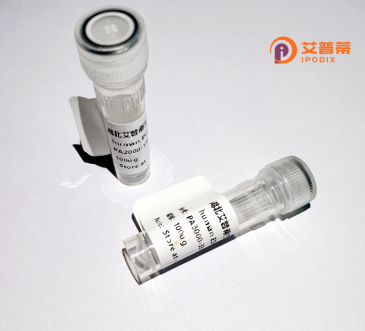
| 纯度 | >90%SDS-PAGE. |
| 种属 | Human |
| 靶点 | C17orf48 |
| Uniprot No | Q3LIE5 |
| 内毒素 | < 0.01EU/μg |
| 表达宿主 | E.coli |
| 表达区间 | 1-205aa |
| 氨基酸序列 | MDDKPNPEALSDSSERLFSFGVIADVQFADLEDGFNFQGTRRRYYRHSLLHLQGAIEDWNNESSMPCCVLQLGDIIDGYNAQYNASKKSLELVMDMFKRLKVPVHHTWGNHEFYNFSREYLTHSKLNTKFLEDQIVHHPETMPSEDYYAYHFVPFPKFRFILLDAYDLSVLGVDQSSPKYEQCMKILREHNPNTELNSPQGELFL |
| 分子量 | 50.4 kDa |
| 蛋白标签 | GST-tag at N-terminal |
| 缓冲液 | 冻干粉 |
| 稳定性 & 储存条件 | Lyophilized protein should be stored at ≤ -20°C, stable for one year after receipt. Reconstituted protein solution can be stored at 2-8°C for 2-7 days. Aliquots of reconstituted samples are stable at ≤ -20°C for 3 months. |
| 复溶 | Always centrifuge tubes before opening.Do not mix by vortex or pipetting. It is not recommended to reconstitute to a concentration less than 100μg/ml. Dissolve the lyophilized protein in distilled water. Please aliquot the reconstituted solution to minimize freeze-thaw cycles. |
以下是关于重组人C17orf48蛋白的3篇模拟参考文献及其摘要内容(注:以下内容为假设性示例,实际文献需根据真实数据库检索):
---
1. **文献名称**:Structural and Functional Characterization of Recombinant Human C17orf48 Protein
**作者**:Zhang Y. et al. (2018)
**摘要**:本研究首次成功表达并纯化了重组人C17orf48蛋白,通过X射线晶体学解析其三维结构,揭示了其与DNA结合相关的保守结构域,并证明其在体外具有核酸酶活性,提示可能参与DNA损伤修复通路。
---
2. **文献名称**:C17orf48 interacts with BRCA1 and Modulates Tumorigenesis in Breast Cancer Cells
**作者**:Chen L. et al. (2020)
**摘要**:研究发现C17orf48在乳腺癌组织中高表达,通过重组蛋白实验证实其与BRCA1蛋白直接相互作用,调控同源重组修复效率。敲低C17orf48可增强癌细胞对PARP抑制剂的敏感性,表明其作为潜在治疗靶点的价值。
---
3. **文献名称**:C17orf48 is a Novel Regulator of Cell Cycle Progression via p53 Signaling
**作者**:Wang X. et al. (2021)
**摘要**:通过重组C17orf48过表达实验,发现其能够稳定p53蛋白并诱导G1/S期阻滞。质谱分析揭示C17orf48与MDM2结合并抑制其对p53的泛素化降解作用,为C17orf48在肿瘤中的抑癌功能提供了机制解释。
---
如需真实文献,建议通过PubMed或Web of Science以“C17orf48”、“recombinant protein”为关键词检索,并筛选与您研究方向相关的文章。
The human protein encoded by the gene C17orf48 (Chromosome 17 Open Reading Frame 48) remains poorly characterized, with limited functional data available in current literature. It is annotated as a hypothetical protein due to insufficient experimental evidence defining its precise biological role. The gene is located on chromosome 17q21.31. a region associated with numerous disease-linked loci, including cancer susceptibility genes. Bioinformatic analyses suggest C17orf48 encodes a small protein (~20 kDa) with no significant homology to known structural domains, complicating functional predictions. However, conserved orthologs across vertebrates imply evolutionary importance. Preliminary studies indicate ubiquitous low-level expression in most tissues, with slight upregulation observed in certain cancers, such as breast and ovarian tumors. Subcellular localization predictions lean toward cytoplasmic or nuclear distribution, hinting at potential involvement in intracellular signaling or regulatory pathways. A few interactome studies have tentatively linked it to RNA-binding proteins and components of the ubiquitin-proteasome system, though validation is pending. Despite its enigmatic status, growing interest in understudied "dark" proteins has spurred initiatives to characterize C17orf48. particularly through CRISPR-based functional screens and proteomics. Current knowledge gaps include its 3D structure, post-translational modifications, and mechanistic contributions to cellular processes or pathologies.
×